Cultural Safety Practice: Addressing Homelessness in Healthcare
VerifiedAdded on 2022/09/13
|14
|3673
|10
Report
AI Summary
This report explores the concept of cultural safety in healthcare settings, emphasizing its importance in providing equitable care to vulnerable populations, particularly those experiencing homelessness. It examines the multifaceted challenges faced by homeless individuals, including health inequitie...
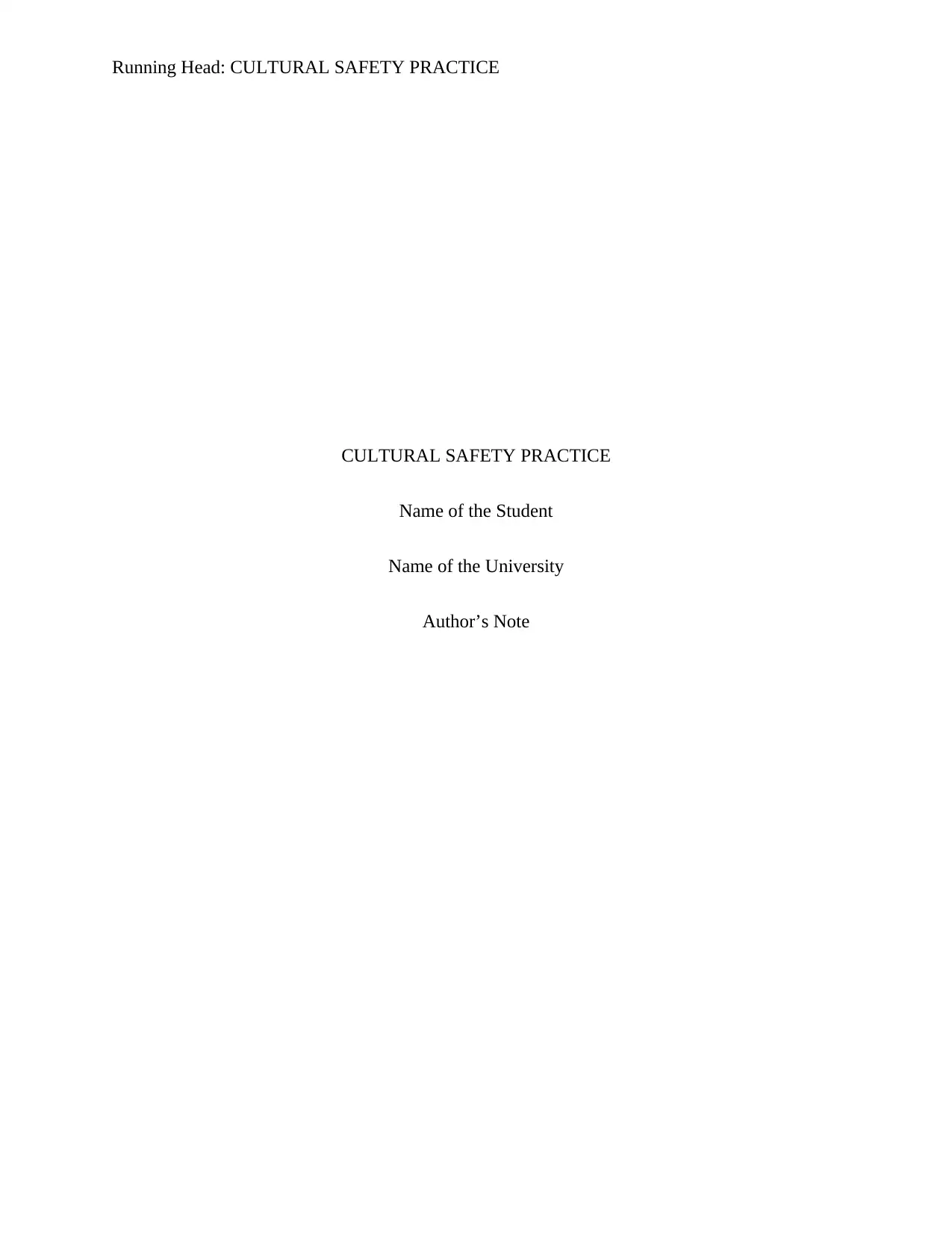
Running Head: CULTURAL SAFETY PRACTICE
CULTURAL SAFETY PRACTICE
Name of the Student
Name of the University
Author’s Note
CULTURAL SAFETY PRACTICE
Name of the Student
Name of the University
Author’s Note
Paraphrase This Document
Need a fresh take? Get an instant paraphrase of this document with our AI Paraphraser
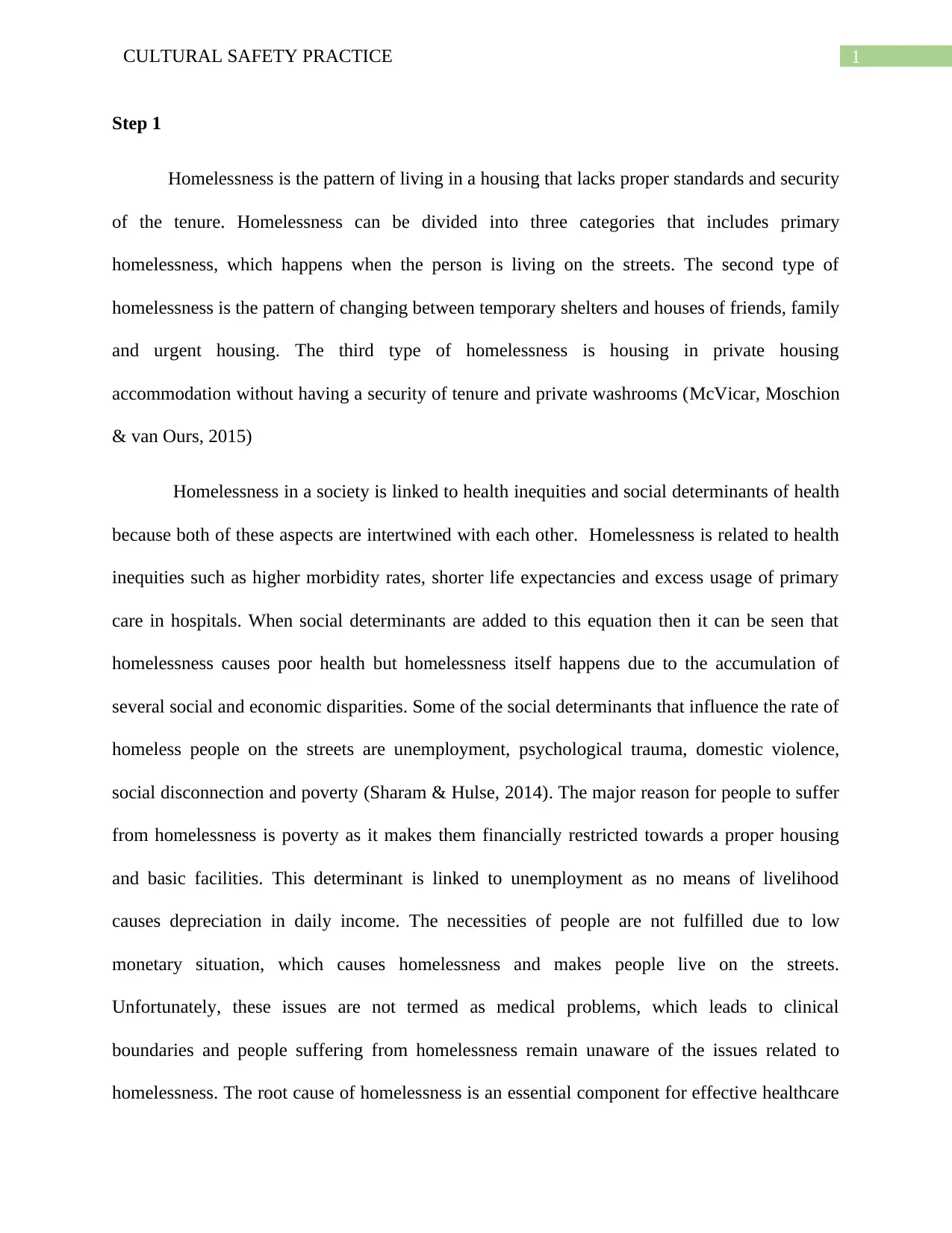
1CULTURAL SAFETY PRACTICE
Step 1
Homelessness is the pattern of living in a housing that lacks proper standards and security
of the tenure. Homelessness can be divided into three categories that includes primary
homelessness, which happens when the person is living on the streets. The second type of
homelessness is the pattern of changing between temporary shelters and houses of friends, family
and urgent housing. The third type of homelessness is housing in private housing
accommodation without having a security of tenure and private washrooms (McVicar, Moschion
& van Ours, 2015)
Homelessness in a society is linked to health inequities and social determinants of health
because both of these aspects are intertwined with each other. Homelessness is related to health
inequities such as higher morbidity rates, shorter life expectancies and excess usage of primary
care in hospitals. When social determinants are added to this equation then it can be seen that
homelessness causes poor health but homelessness itself happens due to the accumulation of
several social and economic disparities. Some of the social determinants that influence the rate of
homeless people on the streets are unemployment, psychological trauma, domestic violence,
social disconnection and poverty (Sharam & Hulse, 2014). The major reason for people to suffer
from homelessness is poverty as it makes them financially restricted towards a proper housing
and basic facilities. This determinant is linked to unemployment as no means of livelihood
causes depreciation in daily income. The necessities of people are not fulfilled due to low
monetary situation, which causes homelessness and makes people live on the streets.
Unfortunately, these issues are not termed as medical problems, which leads to clinical
boundaries and people suffering from homelessness remain unaware of the issues related to
homelessness. The root cause of homelessness is an essential component for effective healthcare
Step 1
Homelessness is the pattern of living in a housing that lacks proper standards and security
of the tenure. Homelessness can be divided into three categories that includes primary
homelessness, which happens when the person is living on the streets. The second type of
homelessness is the pattern of changing between temporary shelters and houses of friends, family
and urgent housing. The third type of homelessness is housing in private housing
accommodation without having a security of tenure and private washrooms (McVicar, Moschion
& van Ours, 2015)
Homelessness in a society is linked to health inequities and social determinants of health
because both of these aspects are intertwined with each other. Homelessness is related to health
inequities such as higher morbidity rates, shorter life expectancies and excess usage of primary
care in hospitals. When social determinants are added to this equation then it can be seen that
homelessness causes poor health but homelessness itself happens due to the accumulation of
several social and economic disparities. Some of the social determinants that influence the rate of
homeless people on the streets are unemployment, psychological trauma, domestic violence,
social disconnection and poverty (Sharam & Hulse, 2014). The major reason for people to suffer
from homelessness is poverty as it makes them financially restricted towards a proper housing
and basic facilities. This determinant is linked to unemployment as no means of livelihood
causes depreciation in daily income. The necessities of people are not fulfilled due to low
monetary situation, which causes homelessness and makes people live on the streets.
Unfortunately, these issues are not termed as medical problems, which leads to clinical
boundaries and people suffering from homelessness remain unaware of the issues related to
homelessness. The root cause of homelessness is an essential component for effective healthcare
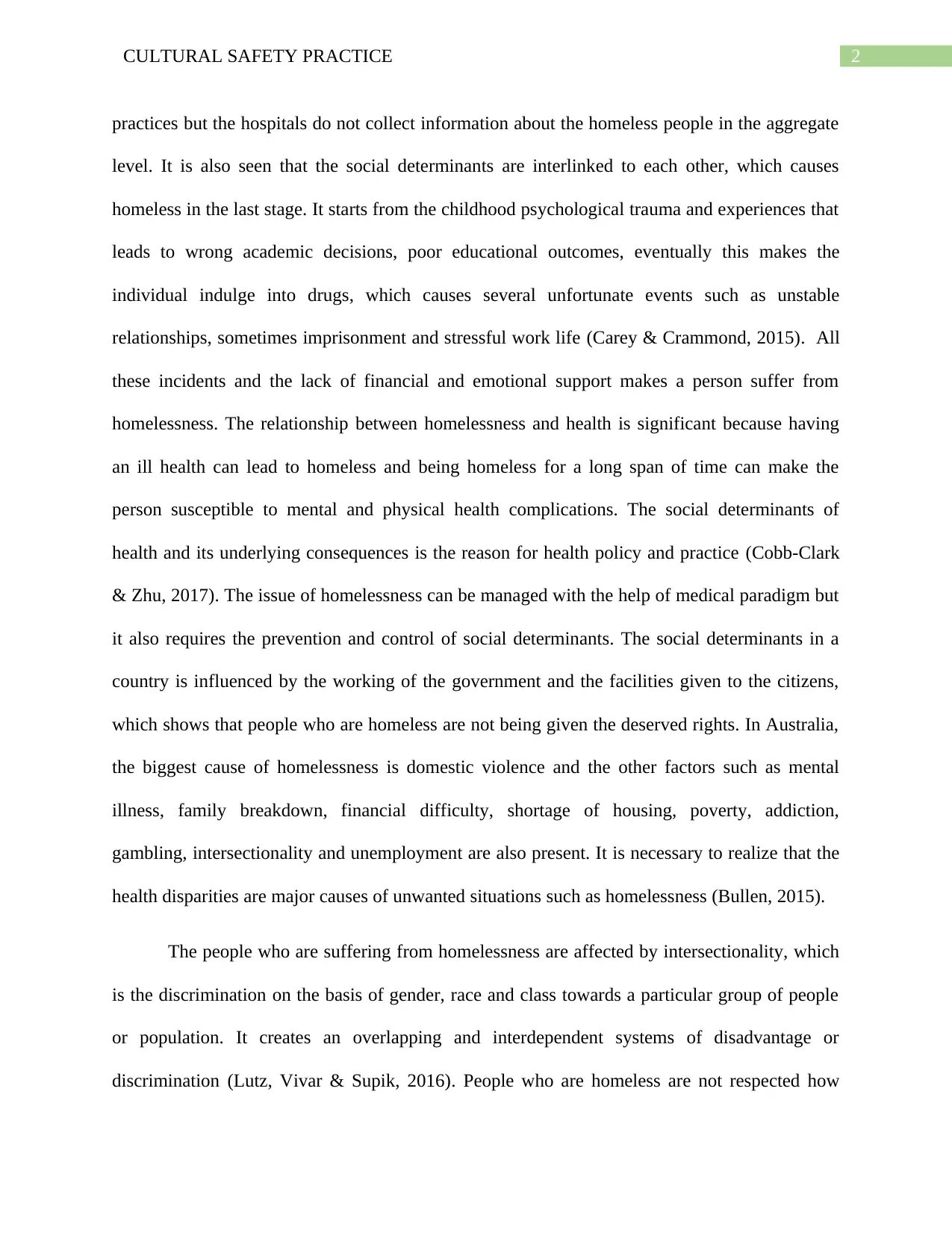
2CULTURAL SAFETY PRACTICE
practices but the hospitals do not collect information about the homeless people in the aggregate
level. It is also seen that the social determinants are interlinked to each other, which causes
homeless in the last stage. It starts from the childhood psychological trauma and experiences that
leads to wrong academic decisions, poor educational outcomes, eventually this makes the
individual indulge into drugs, which causes several unfortunate events such as unstable
relationships, sometimes imprisonment and stressful work life (Carey & Crammond, 2015). All
these incidents and the lack of financial and emotional support makes a person suffer from
homelessness. The relationship between homelessness and health is significant because having
an ill health can lead to homeless and being homeless for a long span of time can make the
person susceptible to mental and physical health complications. The social determinants of
health and its underlying consequences is the reason for health policy and practice (Cobb-Clark
& Zhu, 2017). The issue of homelessness can be managed with the help of medical paradigm but
it also requires the prevention and control of social determinants. The social determinants in a
country is influenced by the working of the government and the facilities given to the citizens,
which shows that people who are homeless are not being given the deserved rights. In Australia,
the biggest cause of homelessness is domestic violence and the other factors such as mental
illness, family breakdown, financial difficulty, shortage of housing, poverty, addiction,
gambling, intersectionality and unemployment are also present. It is necessary to realize that the
health disparities are major causes of unwanted situations such as homelessness (Bullen, 2015).
The people who are suffering from homelessness are affected by intersectionality, which
is the discrimination on the basis of gender, race and class towards a particular group of people
or population. It creates an overlapping and interdependent systems of disadvantage or
discrimination (Lutz, Vivar & Supik, 2016). People who are homeless are not respected how
practices but the hospitals do not collect information about the homeless people in the aggregate
level. It is also seen that the social determinants are interlinked to each other, which causes
homeless in the last stage. It starts from the childhood psychological trauma and experiences that
leads to wrong academic decisions, poor educational outcomes, eventually this makes the
individual indulge into drugs, which causes several unfortunate events such as unstable
relationships, sometimes imprisonment and stressful work life (Carey & Crammond, 2015). All
these incidents and the lack of financial and emotional support makes a person suffer from
homelessness. The relationship between homelessness and health is significant because having
an ill health can lead to homeless and being homeless for a long span of time can make the
person susceptible to mental and physical health complications. The social determinants of
health and its underlying consequences is the reason for health policy and practice (Cobb-Clark
& Zhu, 2017). The issue of homelessness can be managed with the help of medical paradigm but
it also requires the prevention and control of social determinants. The social determinants in a
country is influenced by the working of the government and the facilities given to the citizens,
which shows that people who are homeless are not being given the deserved rights. In Australia,
the biggest cause of homelessness is domestic violence and the other factors such as mental
illness, family breakdown, financial difficulty, shortage of housing, poverty, addiction,
gambling, intersectionality and unemployment are also present. It is necessary to realize that the
health disparities are major causes of unwanted situations such as homelessness (Bullen, 2015).
The people who are suffering from homelessness are affected by intersectionality, which
is the discrimination on the basis of gender, race and class towards a particular group of people
or population. It creates an overlapping and interdependent systems of disadvantage or
discrimination (Lutz, Vivar & Supik, 2016). People who are homeless are not respected how
You're viewing a preview
Unlock full access by subscribing today!
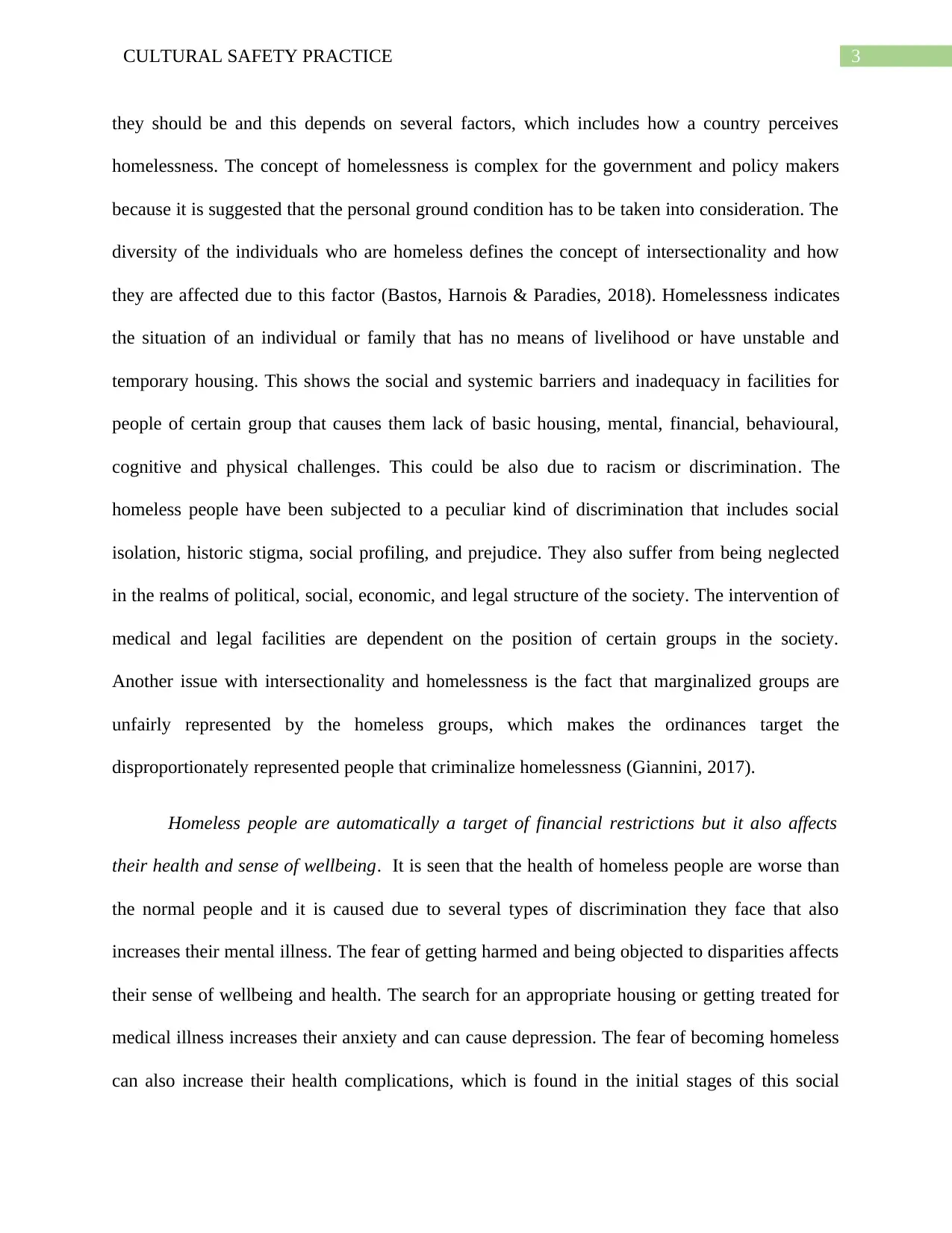
3CULTURAL SAFETY PRACTICE
they should be and this depends on several factors, which includes how a country perceives
homelessness. The concept of homelessness is complex for the government and policy makers
because it is suggested that the personal ground condition has to be taken into consideration. The
diversity of the individuals who are homeless defines the concept of intersectionality and how
they are affected due to this factor (Bastos, Harnois & Paradies, 2018). Homelessness indicates
the situation of an individual or family that has no means of livelihood or have unstable and
temporary housing. This shows the social and systemic barriers and inadequacy in facilities for
people of certain group that causes them lack of basic housing, mental, financial, behavioural,
cognitive and physical challenges. This could be also due to racism or discrimination. The
homeless people have been subjected to a peculiar kind of discrimination that includes social
isolation, historic stigma, social profiling, and prejudice. They also suffer from being neglected
in the realms of political, social, economic, and legal structure of the society. The intervention of
medical and legal facilities are dependent on the position of certain groups in the society.
Another issue with intersectionality and homelessness is the fact that marginalized groups are
unfairly represented by the homeless groups, which makes the ordinances target the
disproportionately represented people that criminalize homelessness (Giannini, 2017).
Homeless people are automatically a target of financial restrictions but it also affects
their health and sense of wellbeing. It is seen that the health of homeless people are worse than
the normal people and it is caused due to several types of discrimination they face that also
increases their mental illness. The fear of getting harmed and being objected to disparities affects
their sense of wellbeing and health. The search for an appropriate housing or getting treated for
medical illness increases their anxiety and can cause depression. The fear of becoming homeless
can also increase their health complications, which is found in the initial stages of this social
they should be and this depends on several factors, which includes how a country perceives
homelessness. The concept of homelessness is complex for the government and policy makers
because it is suggested that the personal ground condition has to be taken into consideration. The
diversity of the individuals who are homeless defines the concept of intersectionality and how
they are affected due to this factor (Bastos, Harnois & Paradies, 2018). Homelessness indicates
the situation of an individual or family that has no means of livelihood or have unstable and
temporary housing. This shows the social and systemic barriers and inadequacy in facilities for
people of certain group that causes them lack of basic housing, mental, financial, behavioural,
cognitive and physical challenges. This could be also due to racism or discrimination. The
homeless people have been subjected to a peculiar kind of discrimination that includes social
isolation, historic stigma, social profiling, and prejudice. They also suffer from being neglected
in the realms of political, social, economic, and legal structure of the society. The intervention of
medical and legal facilities are dependent on the position of certain groups in the society.
Another issue with intersectionality and homelessness is the fact that marginalized groups are
unfairly represented by the homeless groups, which makes the ordinances target the
disproportionately represented people that criminalize homelessness (Giannini, 2017).
Homeless people are automatically a target of financial restrictions but it also affects
their health and sense of wellbeing. It is seen that the health of homeless people are worse than
the normal people and it is caused due to several types of discrimination they face that also
increases their mental illness. The fear of getting harmed and being objected to disparities affects
their sense of wellbeing and health. The search for an appropriate housing or getting treated for
medical illness increases their anxiety and can cause depression. The fear of becoming homeless
can also increase their health complications, which is found in the initial stages of this social
Paraphrase This Document
Need a fresh take? Get an instant paraphrase of this document with our AI Paraphraser
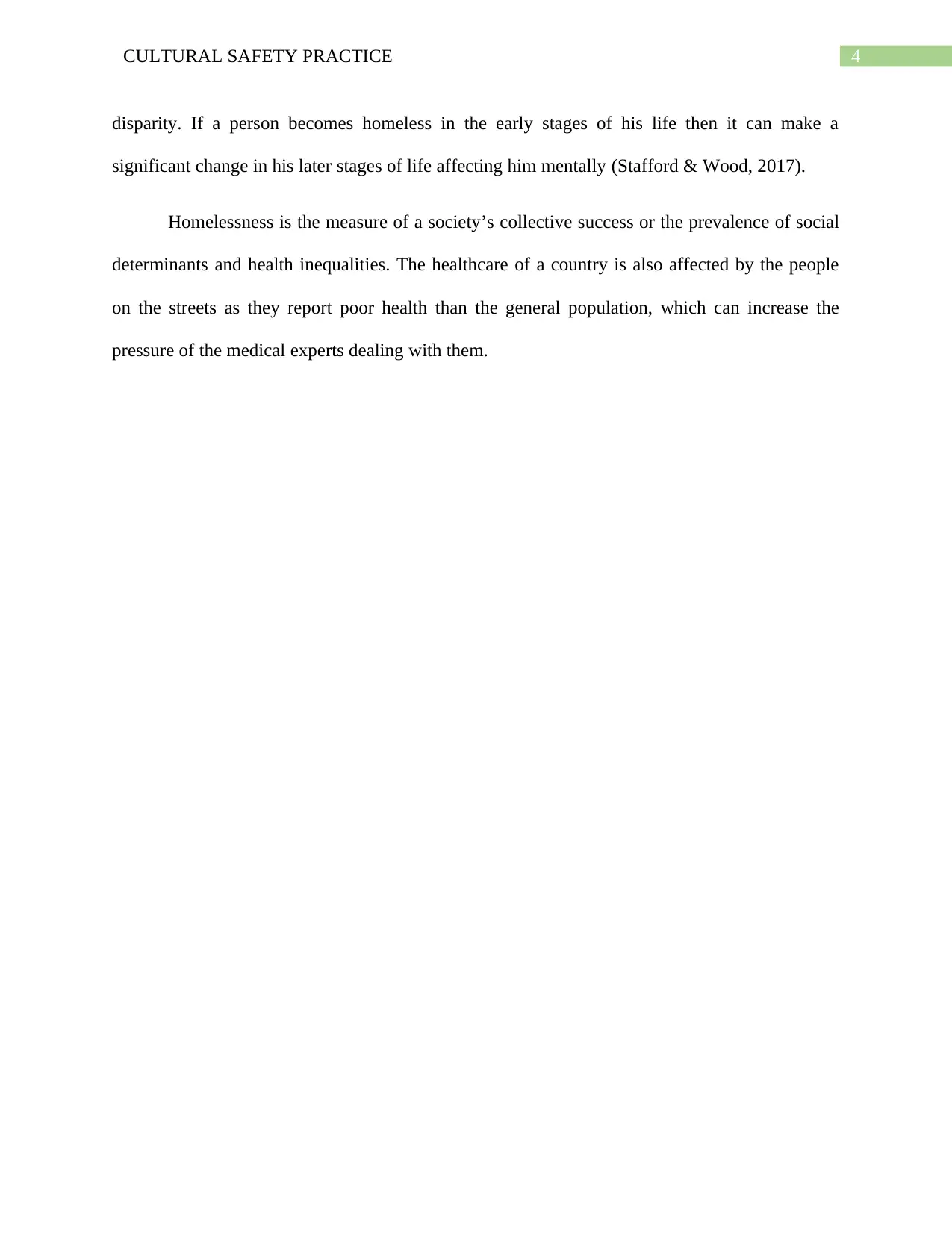
4CULTURAL SAFETY PRACTICE
disparity. If a person becomes homeless in the early stages of his life then it can make a
significant change in his later stages of life affecting him mentally (Stafford & Wood, 2017).
Homelessness is the measure of a society’s collective success or the prevalence of social
determinants and health inequalities. The healthcare of a country is also affected by the people
on the streets as they report poor health than the general population, which can increase the
pressure of the medical experts dealing with them.
disparity. If a person becomes homeless in the early stages of his life then it can make a
significant change in his later stages of life affecting him mentally (Stafford & Wood, 2017).
Homelessness is the measure of a society’s collective success or the prevalence of social
determinants and health inequalities. The healthcare of a country is also affected by the people
on the streets as they report poor health than the general population, which can increase the
pressure of the medical experts dealing with them.
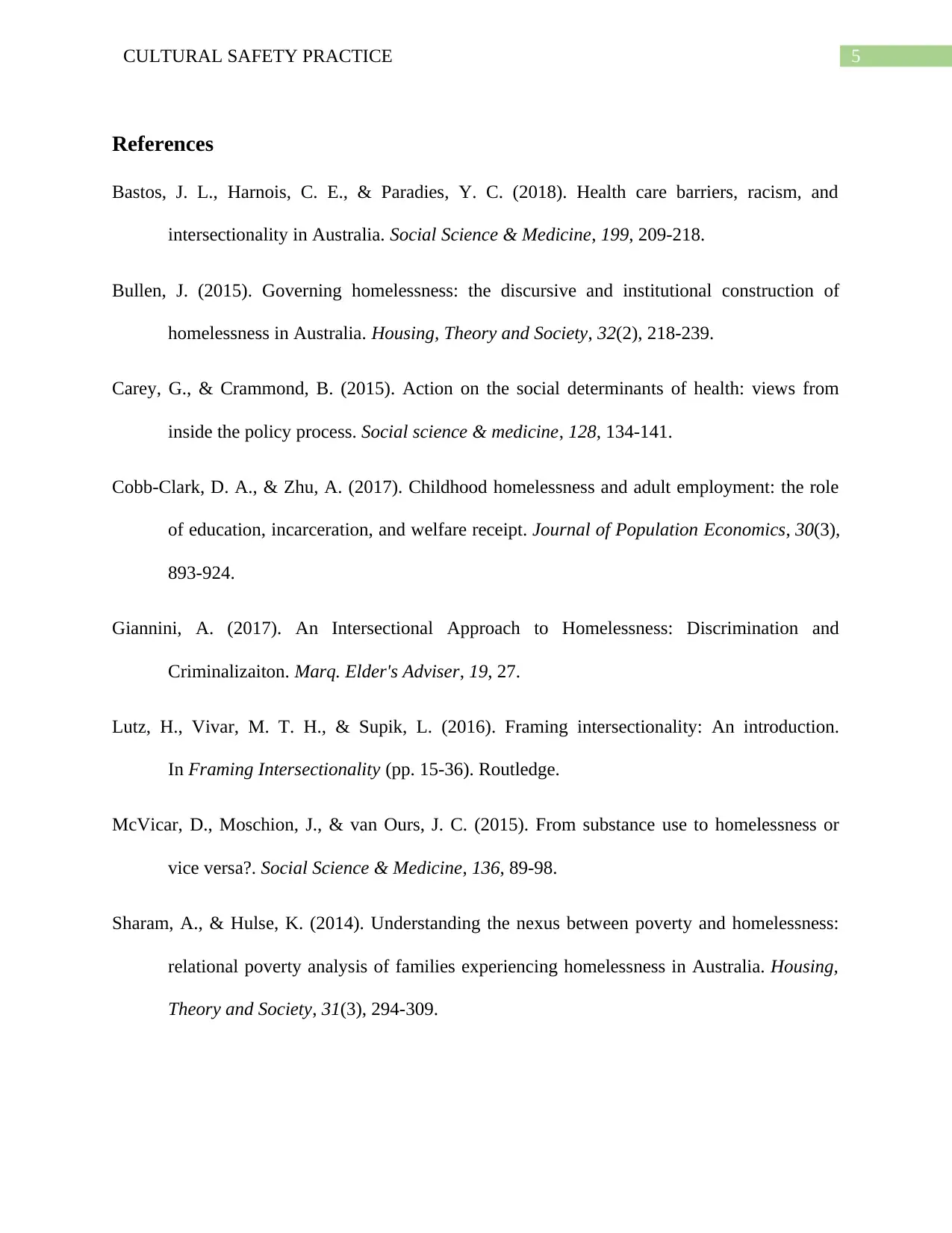
5CULTURAL SAFETY PRACTICE
References
Bastos, J. L., Harnois, C. E., & Paradies, Y. C. (2018). Health care barriers, racism, and
intersectionality in Australia. Social Science & Medicine, 199, 209-218.
Bullen, J. (2015). Governing homelessness: the discursive and institutional construction of
homelessness in Australia. Housing, Theory and Society, 32(2), 218-239.
Carey, G., & Crammond, B. (2015). Action on the social determinants of health: views from
inside the policy process. Social science & medicine, 128, 134-141.
Cobb-Clark, D. A., & Zhu, A. (2017). Childhood homelessness and adult employment: the role
of education, incarceration, and welfare receipt. Journal of Population Economics, 30(3),
893-924.
Giannini, A. (2017). An Intersectional Approach to Homelessness: Discrimination and
Criminalizaiton. Marq. Elder's Adviser, 19, 27.
Lutz, H., Vivar, M. T. H., & Supik, L. (2016). Framing intersectionality: An introduction.
In Framing Intersectionality (pp. 15-36). Routledge.
McVicar, D., Moschion, J., & van Ours, J. C. (2015). From substance use to homelessness or
vice versa?. Social Science & Medicine, 136, 89-98.
Sharam, A., & Hulse, K. (2014). Understanding the nexus between poverty and homelessness:
relational poverty analysis of families experiencing homelessness in Australia. Housing,
Theory and Society, 31(3), 294-309.
References
Bastos, J. L., Harnois, C. E., & Paradies, Y. C. (2018). Health care barriers, racism, and
intersectionality in Australia. Social Science & Medicine, 199, 209-218.
Bullen, J. (2015). Governing homelessness: the discursive and institutional construction of
homelessness in Australia. Housing, Theory and Society, 32(2), 218-239.
Carey, G., & Crammond, B. (2015). Action on the social determinants of health: views from
inside the policy process. Social science & medicine, 128, 134-141.
Cobb-Clark, D. A., & Zhu, A. (2017). Childhood homelessness and adult employment: the role
of education, incarceration, and welfare receipt. Journal of Population Economics, 30(3),
893-924.
Giannini, A. (2017). An Intersectional Approach to Homelessness: Discrimination and
Criminalizaiton. Marq. Elder's Adviser, 19, 27.
Lutz, H., Vivar, M. T. H., & Supik, L. (2016). Framing intersectionality: An introduction.
In Framing Intersectionality (pp. 15-36). Routledge.
McVicar, D., Moschion, J., & van Ours, J. C. (2015). From substance use to homelessness or
vice versa?. Social Science & Medicine, 136, 89-98.
Sharam, A., & Hulse, K. (2014). Understanding the nexus between poverty and homelessness:
relational poverty analysis of families experiencing homelessness in Australia. Housing,
Theory and Society, 31(3), 294-309.
You're viewing a preview
Unlock full access by subscribing today!
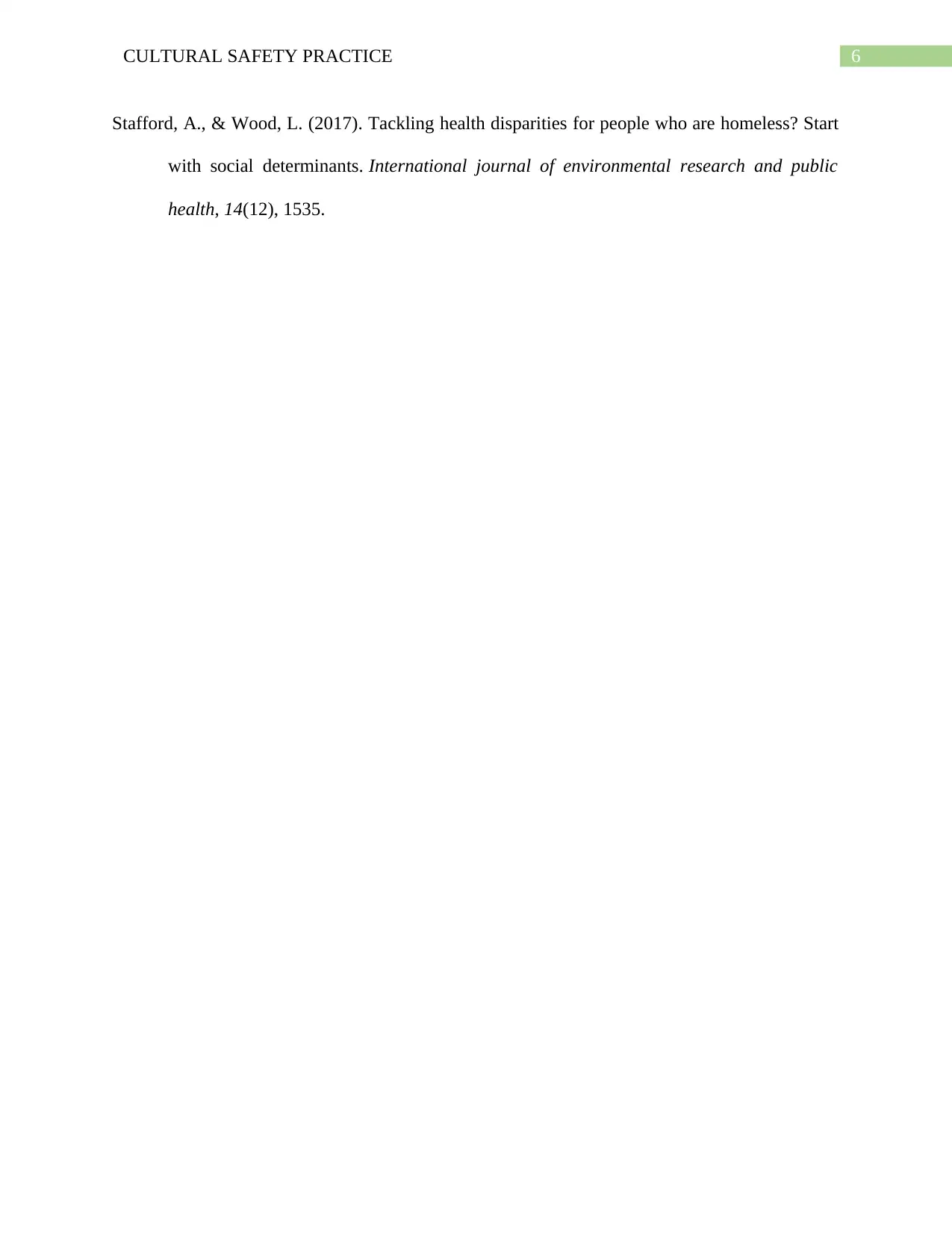
6CULTURAL SAFETY PRACTICE
Stafford, A., & Wood, L. (2017). Tackling health disparities for people who are homeless? Start
with social determinants. International journal of environmental research and public
health, 14(12), 1535.
Stafford, A., & Wood, L. (2017). Tackling health disparities for people who are homeless? Start
with social determinants. International journal of environmental research and public
health, 14(12), 1535.
Paraphrase This Document
Need a fresh take? Get an instant paraphrase of this document with our AI Paraphraser
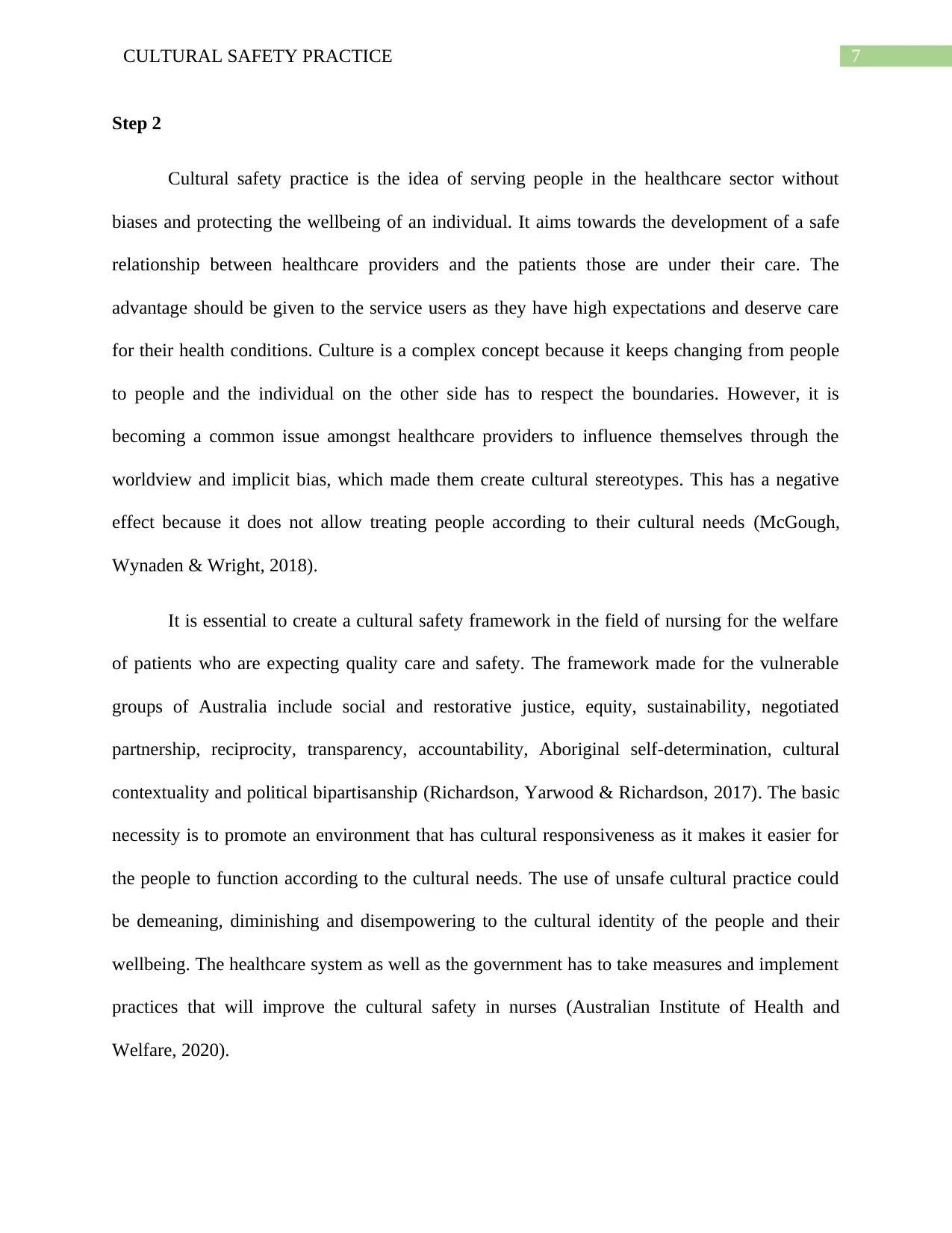
7CULTURAL SAFETY PRACTICE
Step 2
Cultural safety practice is the idea of serving people in the healthcare sector without
biases and protecting the wellbeing of an individual. It aims towards the development of a safe
relationship between healthcare providers and the patients those are under their care. The
advantage should be given to the service users as they have high expectations and deserve care
for their health conditions. Culture is a complex concept because it keeps changing from people
to people and the individual on the other side has to respect the boundaries. However, it is
becoming a common issue amongst healthcare providers to influence themselves through the
worldview and implicit bias, which made them create cultural stereotypes. This has a negative
effect because it does not allow treating people according to their cultural needs (McGough,
Wynaden & Wright, 2018).
It is essential to create a cultural safety framework in the field of nursing for the welfare
of patients who are expecting quality care and safety. The framework made for the vulnerable
groups of Australia include social and restorative justice, equity, sustainability, negotiated
partnership, reciprocity, transparency, accountability, Aboriginal self-determination, cultural
contextuality and political bipartisanship (Richardson, Yarwood & Richardson, 2017). The basic
necessity is to promote an environment that has cultural responsiveness as it makes it easier for
the people to function according to the cultural needs. The use of unsafe cultural practice could
be demeaning, diminishing and disempowering to the cultural identity of the people and their
wellbeing. The healthcare system as well as the government has to take measures and implement
practices that will improve the cultural safety in nurses (Australian Institute of Health and
Welfare, 2020).
Step 2
Cultural safety practice is the idea of serving people in the healthcare sector without
biases and protecting the wellbeing of an individual. It aims towards the development of a safe
relationship between healthcare providers and the patients those are under their care. The
advantage should be given to the service users as they have high expectations and deserve care
for their health conditions. Culture is a complex concept because it keeps changing from people
to people and the individual on the other side has to respect the boundaries. However, it is
becoming a common issue amongst healthcare providers to influence themselves through the
worldview and implicit bias, which made them create cultural stereotypes. This has a negative
effect because it does not allow treating people according to their cultural needs (McGough,
Wynaden & Wright, 2018).
It is essential to create a cultural safety framework in the field of nursing for the welfare
of patients who are expecting quality care and safety. The framework made for the vulnerable
groups of Australia include social and restorative justice, equity, sustainability, negotiated
partnership, reciprocity, transparency, accountability, Aboriginal self-determination, cultural
contextuality and political bipartisanship (Richardson, Yarwood & Richardson, 2017). The basic
necessity is to promote an environment that has cultural responsiveness as it makes it easier for
the people to function according to the cultural needs. The use of unsafe cultural practice could
be demeaning, diminishing and disempowering to the cultural identity of the people and their
wellbeing. The healthcare system as well as the government has to take measures and implement
practices that will improve the cultural safety in nurses (Australian Institute of Health and
Welfare, 2020).
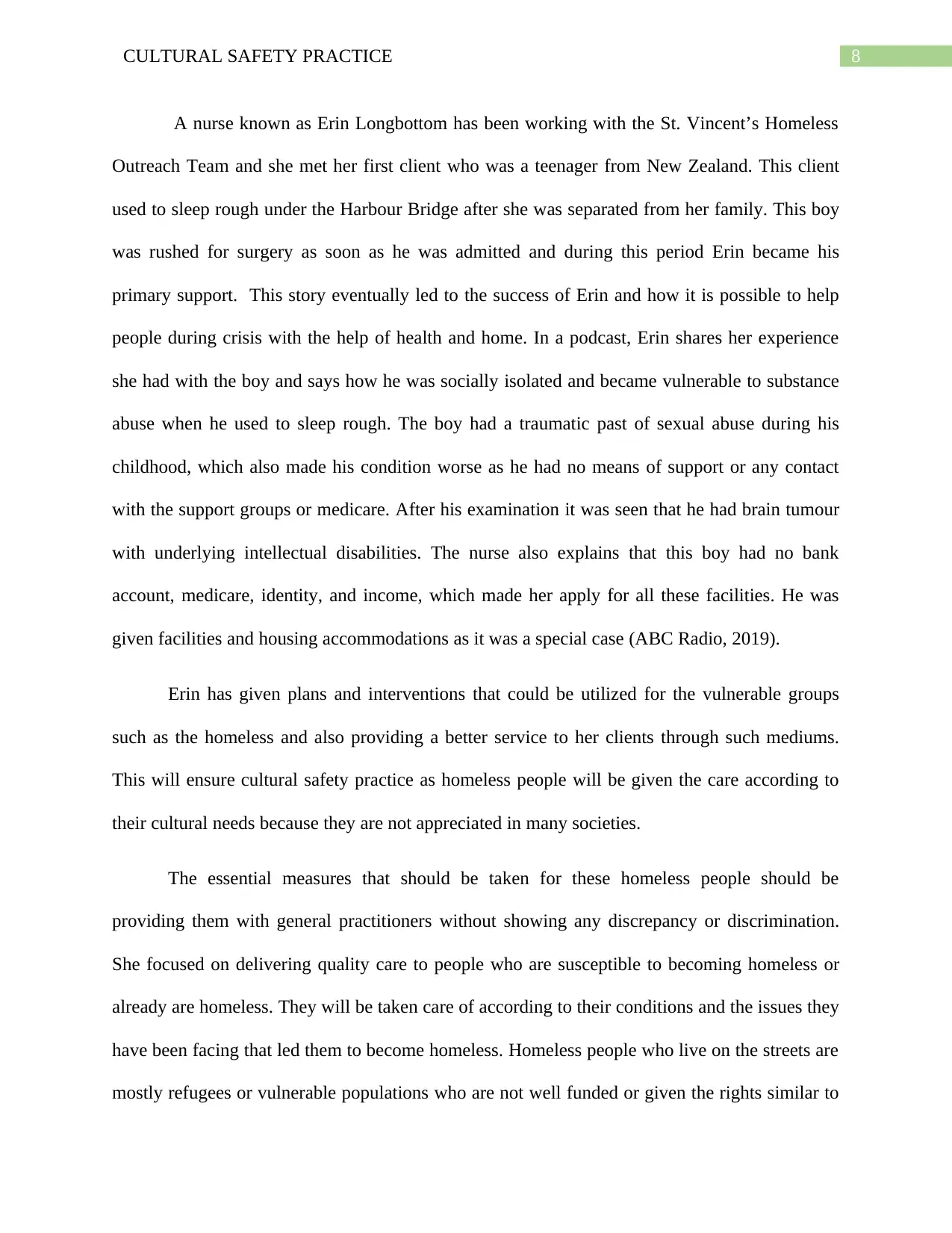
8CULTURAL SAFETY PRACTICE
A nurse known as Erin Longbottom has been working with the St. Vincent’s Homeless
Outreach Team and she met her first client who was a teenager from New Zealand. This client
used to sleep rough under the Harbour Bridge after she was separated from her family. This boy
was rushed for surgery as soon as he was admitted and during this period Erin became his
primary support. This story eventually led to the success of Erin and how it is possible to help
people during crisis with the help of health and home. In a podcast, Erin shares her experience
she had with the boy and says how he was socially isolated and became vulnerable to substance
abuse when he used to sleep rough. The boy had a traumatic past of sexual abuse during his
childhood, which also made his condition worse as he had no means of support or any contact
with the support groups or medicare. After his examination it was seen that he had brain tumour
with underlying intellectual disabilities. The nurse also explains that this boy had no bank
account, medicare, identity, and income, which made her apply for all these facilities. He was
given facilities and housing accommodations as it was a special case (ABC Radio, 2019).
Erin has given plans and interventions that could be utilized for the vulnerable groups
such as the homeless and also providing a better service to her clients through such mediums.
This will ensure cultural safety practice as homeless people will be given the care according to
their cultural needs because they are not appreciated in many societies.
The essential measures that should be taken for these homeless people should be
providing them with general practitioners without showing any discrepancy or discrimination.
She focused on delivering quality care to people who are susceptible to becoming homeless or
already are homeless. They will be taken care of according to their conditions and the issues they
have been facing that led them to become homeless. Homeless people who live on the streets are
mostly refugees or vulnerable populations who are not well funded or given the rights similar to
A nurse known as Erin Longbottom has been working with the St. Vincent’s Homeless
Outreach Team and she met her first client who was a teenager from New Zealand. This client
used to sleep rough under the Harbour Bridge after she was separated from her family. This boy
was rushed for surgery as soon as he was admitted and during this period Erin became his
primary support. This story eventually led to the success of Erin and how it is possible to help
people during crisis with the help of health and home. In a podcast, Erin shares her experience
she had with the boy and says how he was socially isolated and became vulnerable to substance
abuse when he used to sleep rough. The boy had a traumatic past of sexual abuse during his
childhood, which also made his condition worse as he had no means of support or any contact
with the support groups or medicare. After his examination it was seen that he had brain tumour
with underlying intellectual disabilities. The nurse also explains that this boy had no bank
account, medicare, identity, and income, which made her apply for all these facilities. He was
given facilities and housing accommodations as it was a special case (ABC Radio, 2019).
Erin has given plans and interventions that could be utilized for the vulnerable groups
such as the homeless and also providing a better service to her clients through such mediums.
This will ensure cultural safety practice as homeless people will be given the care according to
their cultural needs because they are not appreciated in many societies.
The essential measures that should be taken for these homeless people should be
providing them with general practitioners without showing any discrepancy or discrimination.
She focused on delivering quality care to people who are susceptible to becoming homeless or
already are homeless. They will be taken care of according to their conditions and the issues they
have been facing that led them to become homeless. Homeless people who live on the streets are
mostly refugees or vulnerable populations who are not well funded or given the rights similar to
You're viewing a preview
Unlock full access by subscribing today!
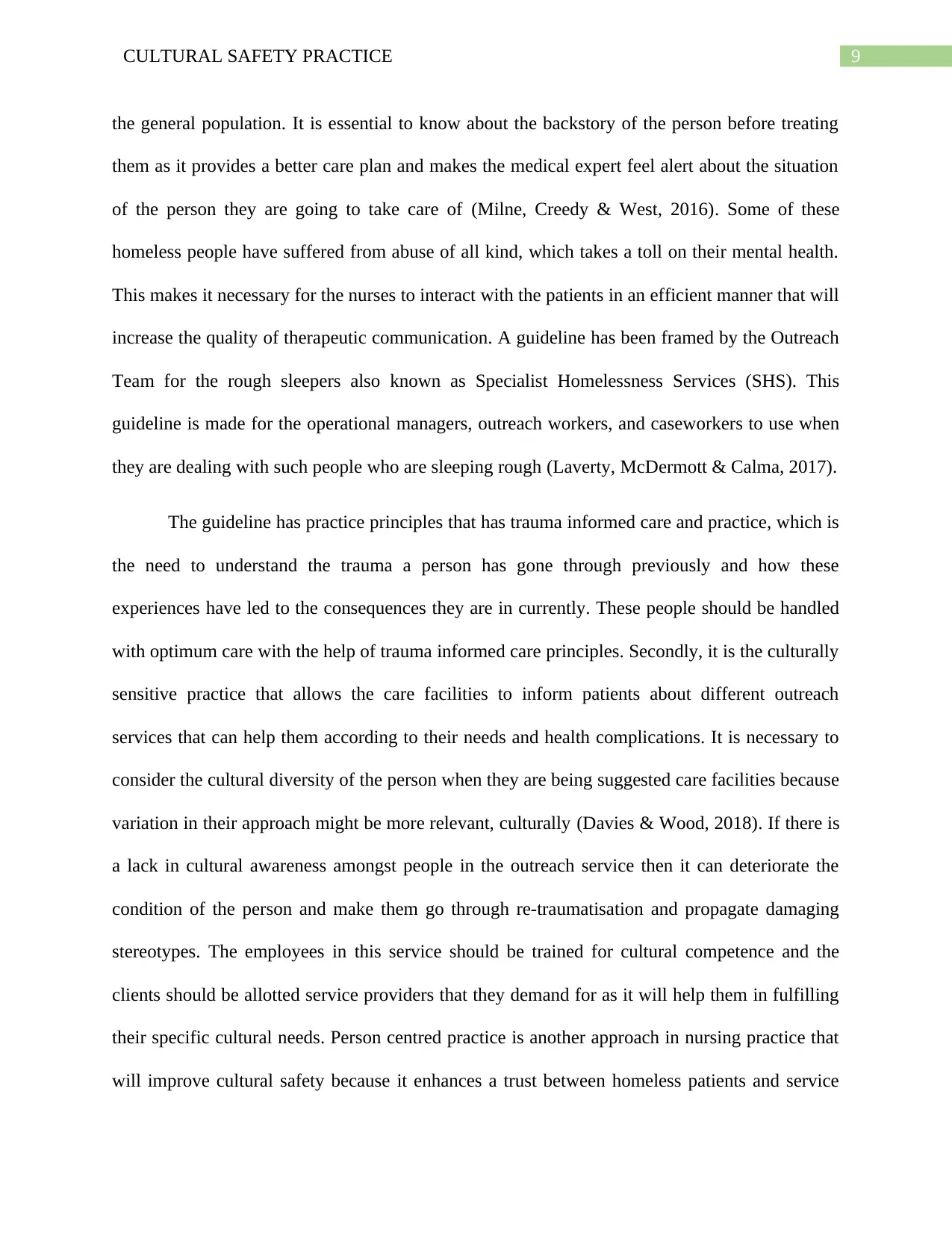
9CULTURAL SAFETY PRACTICE
the general population. It is essential to know about the backstory of the person before treating
them as it provides a better care plan and makes the medical expert feel alert about the situation
of the person they are going to take care of (Milne, Creedy & West, 2016). Some of these
homeless people have suffered from abuse of all kind, which takes a toll on their mental health.
This makes it necessary for the nurses to interact with the patients in an efficient manner that will
increase the quality of therapeutic communication. A guideline has been framed by the Outreach
Team for the rough sleepers also known as Specialist Homelessness Services (SHS). This
guideline is made for the operational managers, outreach workers, and caseworkers to use when
they are dealing with such people who are sleeping rough (Laverty, McDermott & Calma, 2017).
The guideline has practice principles that has trauma informed care and practice, which is
the need to understand the trauma a person has gone through previously and how these
experiences have led to the consequences they are in currently. These people should be handled
with optimum care with the help of trauma informed care principles. Secondly, it is the culturally
sensitive practice that allows the care facilities to inform patients about different outreach
services that can help them according to their needs and health complications. It is necessary to
consider the cultural diversity of the person when they are being suggested care facilities because
variation in their approach might be more relevant, culturally (Davies & Wood, 2018). If there is
a lack in cultural awareness amongst people in the outreach service then it can deteriorate the
condition of the person and make them go through re-traumatisation and propagate damaging
stereotypes. The employees in this service should be trained for cultural competence and the
clients should be allotted service providers that they demand for as it will help them in fulfilling
their specific cultural needs. Person centred practice is another approach in nursing practice that
will improve cultural safety because it enhances a trust between homeless patients and service
the general population. It is essential to know about the backstory of the person before treating
them as it provides a better care plan and makes the medical expert feel alert about the situation
of the person they are going to take care of (Milne, Creedy & West, 2016). Some of these
homeless people have suffered from abuse of all kind, which takes a toll on their mental health.
This makes it necessary for the nurses to interact with the patients in an efficient manner that will
increase the quality of therapeutic communication. A guideline has been framed by the Outreach
Team for the rough sleepers also known as Specialist Homelessness Services (SHS). This
guideline is made for the operational managers, outreach workers, and caseworkers to use when
they are dealing with such people who are sleeping rough (Laverty, McDermott & Calma, 2017).
The guideline has practice principles that has trauma informed care and practice, which is
the need to understand the trauma a person has gone through previously and how these
experiences have led to the consequences they are in currently. These people should be handled
with optimum care with the help of trauma informed care principles. Secondly, it is the culturally
sensitive practice that allows the care facilities to inform patients about different outreach
services that can help them according to their needs and health complications. It is necessary to
consider the cultural diversity of the person when they are being suggested care facilities because
variation in their approach might be more relevant, culturally (Davies & Wood, 2018). If there is
a lack in cultural awareness amongst people in the outreach service then it can deteriorate the
condition of the person and make them go through re-traumatisation and propagate damaging
stereotypes. The employees in this service should be trained for cultural competence and the
clients should be allotted service providers that they demand for as it will help them in fulfilling
their specific cultural needs. Person centred practice is another approach in nursing practice that
will improve cultural safety because it enhances a trust between homeless patients and service
Paraphrase This Document
Need a fresh take? Get an instant paraphrase of this document with our AI Paraphraser
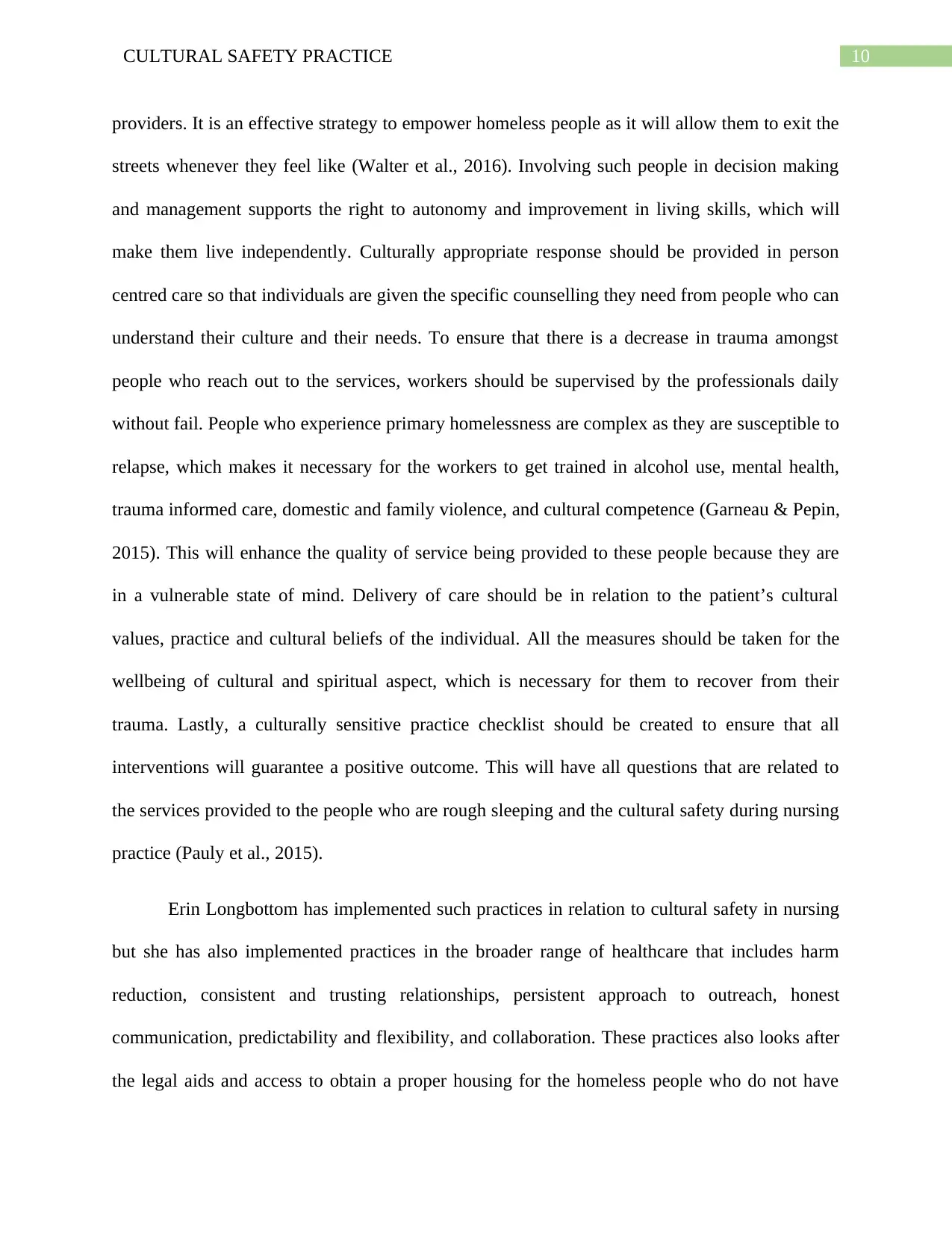
10CULTURAL SAFETY PRACTICE
providers. It is an effective strategy to empower homeless people as it will allow them to exit the
streets whenever they feel like (Walter et al., 2016). Involving such people in decision making
and management supports the right to autonomy and improvement in living skills, which will
make them live independently. Culturally appropriate response should be provided in person
centred care so that individuals are given the specific counselling they need from people who can
understand their culture and their needs. To ensure that there is a decrease in trauma amongst
people who reach out to the services, workers should be supervised by the professionals daily
without fail. People who experience primary homelessness are complex as they are susceptible to
relapse, which makes it necessary for the workers to get trained in alcohol use, mental health,
trauma informed care, domestic and family violence, and cultural competence (Garneau & Pepin,
2015). This will enhance the quality of service being provided to these people because they are
in a vulnerable state of mind. Delivery of care should be in relation to the patient’s cultural
values, practice and cultural beliefs of the individual. All the measures should be taken for the
wellbeing of cultural and spiritual aspect, which is necessary for them to recover from their
trauma. Lastly, a culturally sensitive practice checklist should be created to ensure that all
interventions will guarantee a positive outcome. This will have all questions that are related to
the services provided to the people who are rough sleeping and the cultural safety during nursing
practice (Pauly et al., 2015).
Erin Longbottom has implemented such practices in relation to cultural safety in nursing
but she has also implemented practices in the broader range of healthcare that includes harm
reduction, consistent and trusting relationships, persistent approach to outreach, honest
communication, predictability and flexibility, and collaboration. These practices also looks after
the legal aids and access to obtain a proper housing for the homeless people who do not have
providers. It is an effective strategy to empower homeless people as it will allow them to exit the
streets whenever they feel like (Walter et al., 2016). Involving such people in decision making
and management supports the right to autonomy and improvement in living skills, which will
make them live independently. Culturally appropriate response should be provided in person
centred care so that individuals are given the specific counselling they need from people who can
understand their culture and their needs. To ensure that there is a decrease in trauma amongst
people who reach out to the services, workers should be supervised by the professionals daily
without fail. People who experience primary homelessness are complex as they are susceptible to
relapse, which makes it necessary for the workers to get trained in alcohol use, mental health,
trauma informed care, domestic and family violence, and cultural competence (Garneau & Pepin,
2015). This will enhance the quality of service being provided to these people because they are
in a vulnerable state of mind. Delivery of care should be in relation to the patient’s cultural
values, practice and cultural beliefs of the individual. All the measures should be taken for the
wellbeing of cultural and spiritual aspect, which is necessary for them to recover from their
trauma. Lastly, a culturally sensitive practice checklist should be created to ensure that all
interventions will guarantee a positive outcome. This will have all questions that are related to
the services provided to the people who are rough sleeping and the cultural safety during nursing
practice (Pauly et al., 2015).
Erin Longbottom has implemented such practices in relation to cultural safety in nursing
but she has also implemented practices in the broader range of healthcare that includes harm
reduction, consistent and trusting relationships, persistent approach to outreach, honest
communication, predictability and flexibility, and collaboration. These practices also looks after
the legal aids and access to obtain a proper housing for the homeless people who do not have
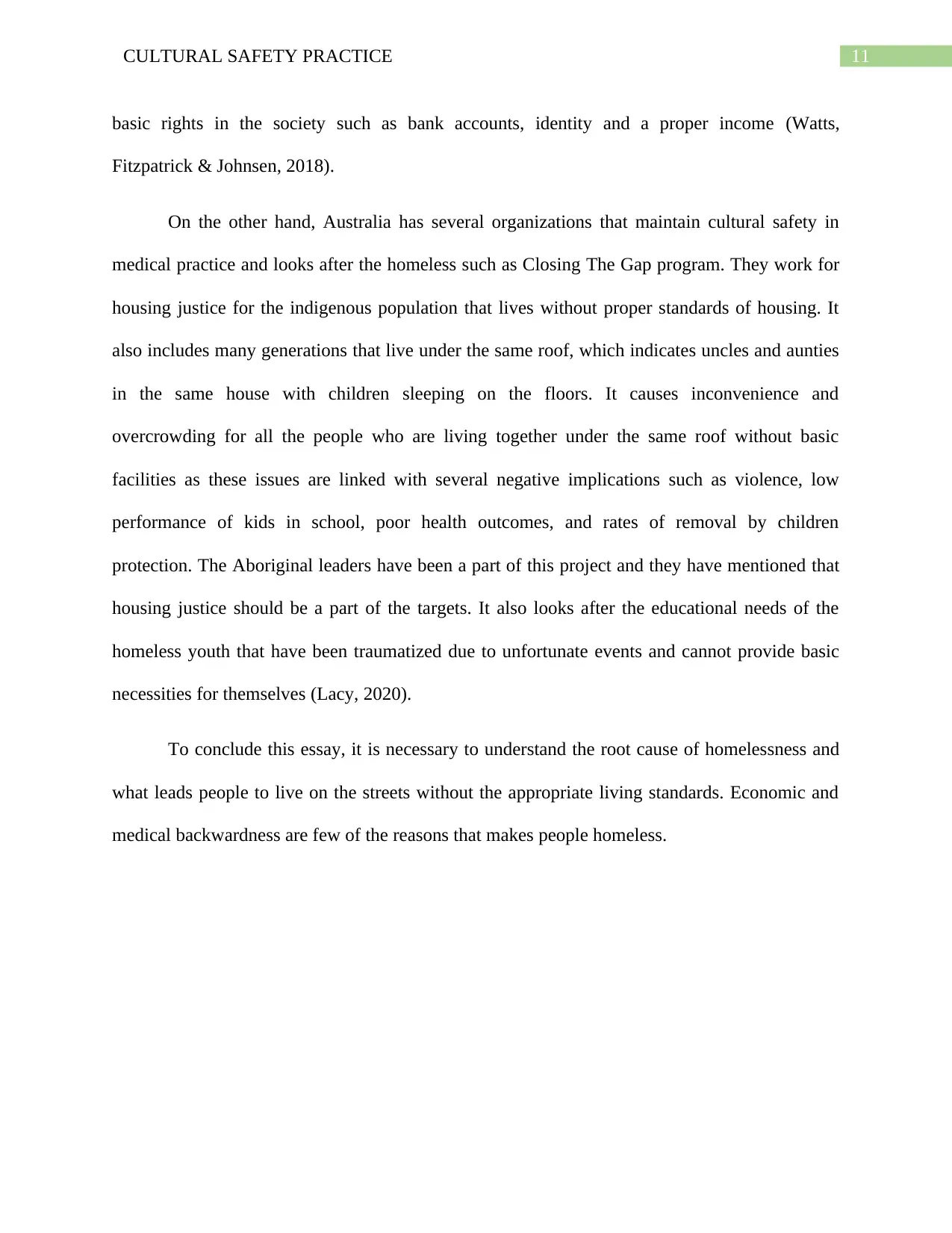
11CULTURAL SAFETY PRACTICE
basic rights in the society such as bank accounts, identity and a proper income (Watts,
Fitzpatrick & Johnsen, 2018).
On the other hand, Australia has several organizations that maintain cultural safety in
medical practice and looks after the homeless such as Closing The Gap program. They work for
housing justice for the indigenous population that lives without proper standards of housing. It
also includes many generations that live under the same roof, which indicates uncles and aunties
in the same house with children sleeping on the floors. It causes inconvenience and
overcrowding for all the people who are living together under the same roof without basic
facilities as these issues are linked with several negative implications such as violence, low
performance of kids in school, poor health outcomes, and rates of removal by children
protection. The Aboriginal leaders have been a part of this project and they have mentioned that
housing justice should be a part of the targets. It also looks after the educational needs of the
homeless youth that have been traumatized due to unfortunate events and cannot provide basic
necessities for themselves (Lacy, 2020).
To conclude this essay, it is necessary to understand the root cause of homelessness and
what leads people to live on the streets without the appropriate living standards. Economic and
medical backwardness are few of the reasons that makes people homeless.
basic rights in the society such as bank accounts, identity and a proper income (Watts,
Fitzpatrick & Johnsen, 2018).
On the other hand, Australia has several organizations that maintain cultural safety in
medical practice and looks after the homeless such as Closing The Gap program. They work for
housing justice for the indigenous population that lives without proper standards of housing. It
also includes many generations that live under the same roof, which indicates uncles and aunties
in the same house with children sleeping on the floors. It causes inconvenience and
overcrowding for all the people who are living together under the same roof without basic
facilities as these issues are linked with several negative implications such as violence, low
performance of kids in school, poor health outcomes, and rates of removal by children
protection. The Aboriginal leaders have been a part of this project and they have mentioned that
housing justice should be a part of the targets. It also looks after the educational needs of the
homeless youth that have been traumatized due to unfortunate events and cannot provide basic
necessities for themselves (Lacy, 2020).
To conclude this essay, it is necessary to understand the root cause of homelessness and
what leads people to live on the streets without the appropriate living standards. Economic and
medical backwardness are few of the reasons that makes people homeless.
You're viewing a preview
Unlock full access by subscribing today!
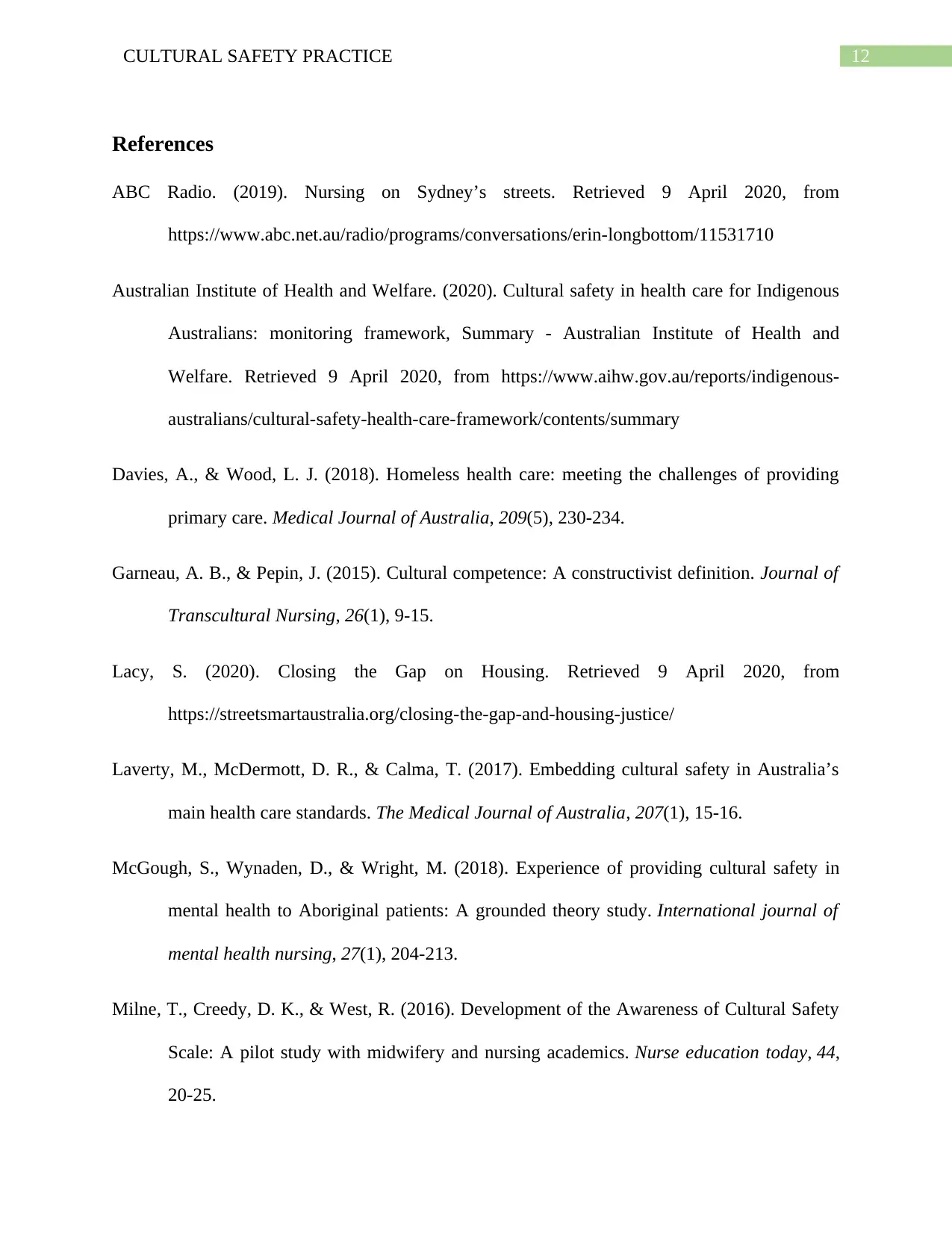
12CULTURAL SAFETY PRACTICE
References
ABC Radio. (2019). Nursing on Sydney’s streets. Retrieved 9 April 2020, from
https://www.abc.net.au/radio/programs/conversations/erin-longbottom/11531710
Australian Institute of Health and Welfare. (2020). Cultural safety in health care for Indigenous
Australians: monitoring framework, Summary - Australian Institute of Health and
Welfare. Retrieved 9 April 2020, from https://www.aihw.gov.au/reports/indigenous-
australians/cultural-safety-health-care-framework/contents/summary
Davies, A., & Wood, L. J. (2018). Homeless health care: meeting the challenges of providing
primary care. Medical Journal of Australia, 209(5), 230-234.
Garneau, A. B., & Pepin, J. (2015). Cultural competence: A constructivist definition. Journal of
Transcultural Nursing, 26(1), 9-15.
Lacy, S. (2020). Closing the Gap on Housing. Retrieved 9 April 2020, from
https://streetsmartaustralia.org/closing-the-gap-and-housing-justice/
Laverty, M., McDermott, D. R., & Calma, T. (2017). Embedding cultural safety in Australia’s
main health care standards. The Medical Journal of Australia, 207(1), 15-16.
McGough, S., Wynaden, D., & Wright, M. (2018). Experience of providing cultural safety in
mental health to Aboriginal patients: A grounded theory study. International journal of
mental health nursing, 27(1), 204-213.
Milne, T., Creedy, D. K., & West, R. (2016). Development of the Awareness of Cultural Safety
Scale: A pilot study with midwifery and nursing academics. Nurse education today, 44,
20-25.
References
ABC Radio. (2019). Nursing on Sydney’s streets. Retrieved 9 April 2020, from
https://www.abc.net.au/radio/programs/conversations/erin-longbottom/11531710
Australian Institute of Health and Welfare. (2020). Cultural safety in health care for Indigenous
Australians: monitoring framework, Summary - Australian Institute of Health and
Welfare. Retrieved 9 April 2020, from https://www.aihw.gov.au/reports/indigenous-
australians/cultural-safety-health-care-framework/contents/summary
Davies, A., & Wood, L. J. (2018). Homeless health care: meeting the challenges of providing
primary care. Medical Journal of Australia, 209(5), 230-234.
Garneau, A. B., & Pepin, J. (2015). Cultural competence: A constructivist definition. Journal of
Transcultural Nursing, 26(1), 9-15.
Lacy, S. (2020). Closing the Gap on Housing. Retrieved 9 April 2020, from
https://streetsmartaustralia.org/closing-the-gap-and-housing-justice/
Laverty, M., McDermott, D. R., & Calma, T. (2017). Embedding cultural safety in Australia’s
main health care standards. The Medical Journal of Australia, 207(1), 15-16.
McGough, S., Wynaden, D., & Wright, M. (2018). Experience of providing cultural safety in
mental health to Aboriginal patients: A grounded theory study. International journal of
mental health nursing, 27(1), 204-213.
Milne, T., Creedy, D. K., & West, R. (2016). Development of the Awareness of Cultural Safety
Scale: A pilot study with midwifery and nursing academics. Nurse education today, 44,
20-25.
Paraphrase This Document
Need a fresh take? Get an instant paraphrase of this document with our AI Paraphraser
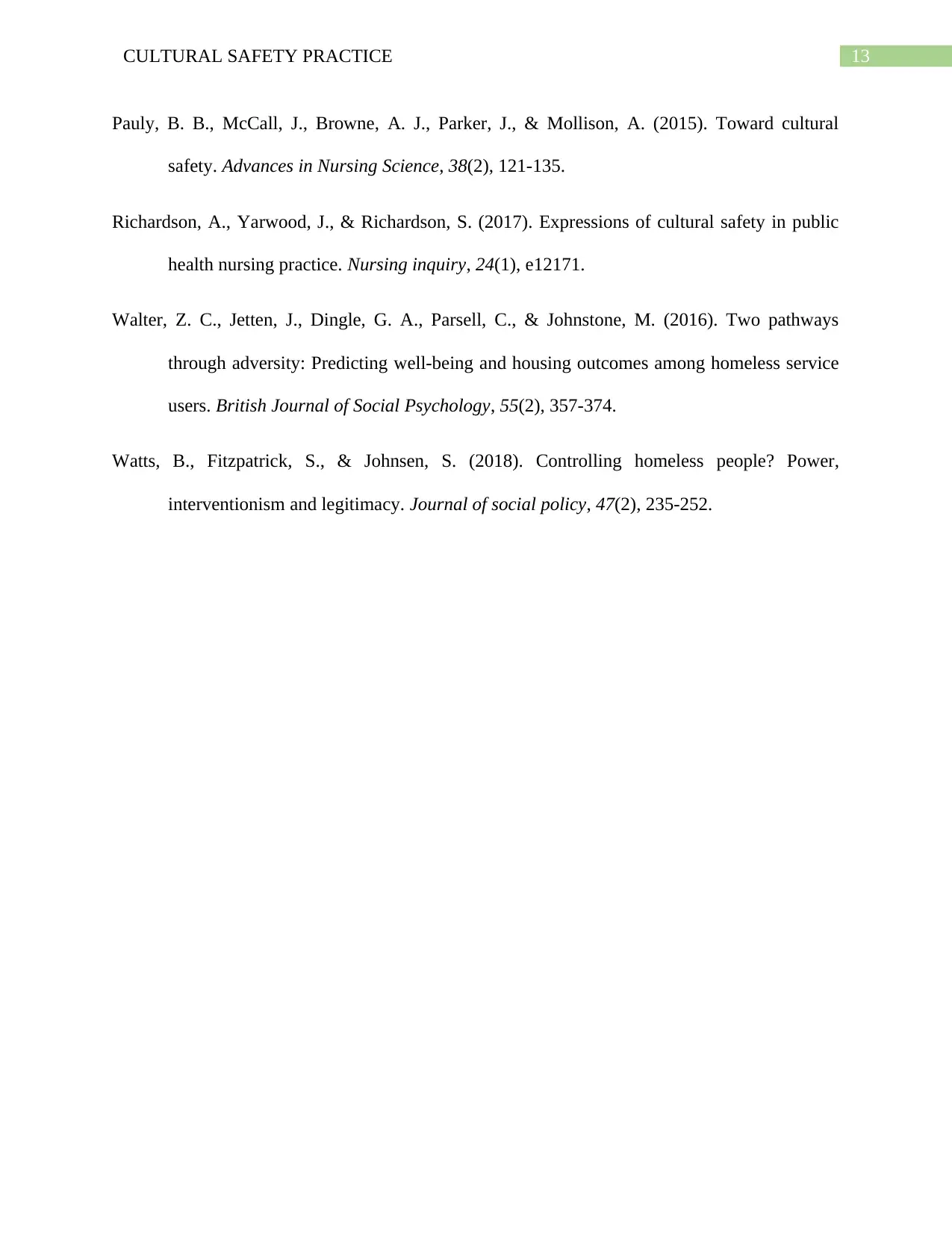
13CULTURAL SAFETY PRACTICE
Pauly, B. B., McCall, J., Browne, A. J., Parker, J., & Mollison, A. (2015). Toward cultural
safety. Advances in Nursing Science, 38(2), 121-135.
Richardson, A., Yarwood, J., & Richardson, S. (2017). Expressions of cultural safety in public
health nursing practice. Nursing inquiry, 24(1), e12171.
Walter, Z. C., Jetten, J., Dingle, G. A., Parsell, C., & Johnstone, M. (2016). Two pathways
through adversity: Predicting well‐being and housing outcomes among homeless service
users. British Journal of Social Psychology, 55(2), 357-374.
Watts, B., Fitzpatrick, S., & Johnsen, S. (2018). Controlling homeless people? Power,
interventionism and legitimacy. Journal of social policy, 47(2), 235-252.
Pauly, B. B., McCall, J., Browne, A. J., Parker, J., & Mollison, A. (2015). Toward cultural
safety. Advances in Nursing Science, 38(2), 121-135.
Richardson, A., Yarwood, J., & Richardson, S. (2017). Expressions of cultural safety in public
health nursing practice. Nursing inquiry, 24(1), e12171.
Walter, Z. C., Jetten, J., Dingle, G. A., Parsell, C., & Johnstone, M. (2016). Two pathways
through adversity: Predicting well‐being and housing outcomes among homeless service
users. British Journal of Social Psychology, 55(2), 357-374.
Watts, B., Fitzpatrick, S., & Johnsen, S. (2018). Controlling homeless people? Power,
interventionism and legitimacy. Journal of social policy, 47(2), 235-252.
1 out of 14
Related Documents
Your All-in-One AI-Powered Toolkit for Academic Success.
+13062052269
info@desklib.com
Available 24*7 on WhatsApp / Email
![[object Object]](/_next/static/media/star-bottom.7253800d.svg)
Unlock your academic potential
© 2024 | Zucol Services PVT LTD | All rights reserved.





